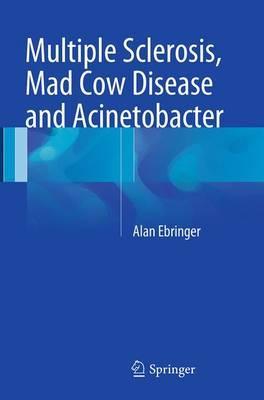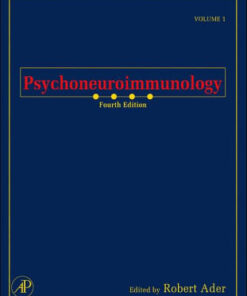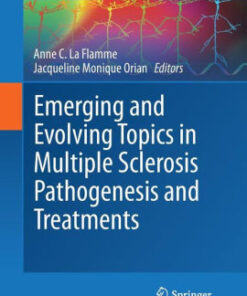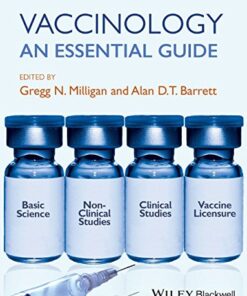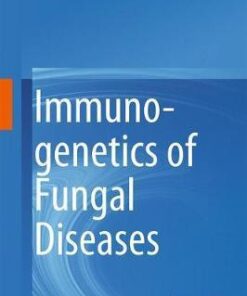(PDF) Multiple Sclerosis, Mad Cow Disease and Acinetobacter By Alan Ebringer
$18.00
Download instantly Multiple Sclerosis, Mad Cow Disease and Acinetobacter By Alan Ebringer. It is ebook in PDF format.
ISBN-10: 3319027344 ISBN-13: 9783319027340
Preview
This is the PDF eBook version for Multiple Sclerosis, Mad Cow Disease and Acinetobacter By Alan Ebringer
Table of Contents
Chapter 1: Multiple Sclerosis as a Scientific Problem
1.1 Multiple Sclerosis: An Introduction
1.2 Clinical Features of Multiple Sclerosis
1.3 Laboratory and Radiological Features
1.4 The Therapy of Multiple Sclerosis
1.5 Molecular Mimicry and Rheumatic Fever
1.6 The Properties of the Multiple Sclerosis Problem
1.7 King’s College Immunology Unit?
References
Chapter 2: History of the Attempts to Find the Origin of Multiple Sclerosis
2.1 Introduction
2.2 Multiple Sclerosis Before Charcot
2.3 Carswell in London
2.4 Cruveilhier in Paris
2.5 Charcot at the Salpetrière
2.6 Multiple Sclerosis in Other Countries
2.7 Microscopy of Multiple Sclerosis Lesions in Edinburgh
2.8 Clues from Therapy
2.9 A “Eureka Moment” in London
References
Chapter 3: The Problem of Bovine Spongiform Encephalopathy also Known as “Mad Cow Disease” in
3.1 First Cases of Bovine Spongiform Encephalopathy in the United Kingdom
3.2 Origin of the Disease
3.3 Scrapie and Related Diseases
3.4 The “Bio-assay” is the Fundamental Flaw in “Transmissible Spongiform Diseases” Researc
3.5 Conclusions
References
Chapter 4: Experimental Allergic Encephalomyelitis as a Model of Multiple Sclerosis
4.1 Post-rabies Vaccination Allergic Encephalomyelitis
4.2 Rabies as a Neurological Disease
4.3 “Experimental Allergic Encephalomyelitis” as an Animal Model of Multiple Sclerosis
4.4 Features of Experimental Allergic Encephalomyelitis
4.5 Conclusions
References
Chapter 5: Bovine Spongiform Encephalopathy: Comparison Between the “Prion” Hypothesis and the
5.1 Bovine Spongiform Encephalopathy as an Environmental and Nutritional Problem Involving Cattle
5.2 Features of Bovine Spongiform Encephalopathy
5.3 The Prion Agent as the Cause of BSE
5.4 Difficulties Associated with the Prion Hypothesis
5.5 General Theory of Autoimmune Diseases
5.6 Experimental Allergic Encephalomyelitis as a Model of BSE
5.7 Growth Hormone Injections as a Cause of CJD or EAE
5.8 The Autoimmune Theory of BSE
5.9 Comparisons Between the Prion Hypothesis and the Autoimmune Theory
References
Chapter 6: Molecular Sequences in EAE and BSE Point to Acinetobacter Bacteria
6.1 Introduction
6.2 Experimental Allergic Encephalomyelitis (EAE) as a Model of an Autoimmune Disease Produced b
6.3 The Hypothesis That BSE Is an Autoimmune Disease
6.4 Molecular Analysis of Myelin Sequences Point to Acinetobacter Bacteria
6.5 Discussion and Conclusions
References
Chapter 7: Autoantibodies to Brain Components and Antibodies to Acinetobacter Are Present in Bov
7.1 Introduction: Bovine Spongiform Encephalopathy or “Mad Cow Disease” Could Be Due to Envir
7.2 Computer Analysis of a Short Sequence of Bovine Myelin Suggests “Molecular Mimicry” with
7.3 Sera from Animals with and Without BSE and from Healthy Animals from an Organic Farm
Sera from Animals with and Without BSE Supplied by the Central Veterinary Laboratory of the M
Control Sera from an Organic Farm Not Associated with MAFF
7.4 Bacterial Cultures, ELISA and Absorption Studies
Bacterial Cultures
ELISA
Absorption Studies
7.5 Measurement of Autoantibodies to Brain Components
7.6 Measurement of Anti-Bacterial Antibodies
7.7 Measurement of Antibodies by Serial Dilutions
7.8 Discussion and Conclusions
References
Chapter 8: Antibodies to Acinetobacter Bacteria But Not to Other Microbes Are Present in Animals
8.1 Introduction: Bovine Spongiform Encephalopathy Could Be Caused by Environmental Bacteria
8.2 Sera from Animals with and Without BSE and Test Bacteria
8.3 Bacterial Cultures, Peptides and ELISA
Bacterial Cultures
Peptides
ELISA
8.4 Measurement of Anti-Bacterial Total Immunoglobulins
8.5 Measurement of Class Specific Anti-Acinetobacter Antibodies
8.6 Measurement of Autoantibodies to Brain Components
8.7 Relative Comparison of Immunoglobulin Isotypes
8.8 Correlation Coefficient Analysis
8.9 Discussion and Conclusions
References
Chapter 9: An Ante-Mortem Test for Bovine Spongiform Encephalopathy Involving “Myelin-Acinetobact
9.1 Introduction: Bovine Spongiform Encephalopathy and Environmental Bacteria
9.2 Sera from Animals with and Without BSE, Test Bacteria and Peptides
9.3 Antibodies to Acinetobacter Peptides and Autoantibodies to Corresponding Bovine Brain Peptide
9.4 An Ante-Mortem Test for BSE
9.5 Sensitivity and Specificity of Ante-Mortem Test
9.6 Discussion and Conclusions
References
Chapter 10: Antibodies to Prion and Acinetobacter Peptide Sequences in Bovine Spongiform Encephal
10.1 Introduction: The Possible Link Between Prions and Acinetobacter Bacteria
10.2 Materials and Methods: Serum Samples, Peptides and ELISA
Serum Samples
Peptides
ELISA
Statistical Studies
10.3 The Presence of Molecular Mimicry Between Bovine Prion and Acinetobacter Sequences
10.4 Antibodies to Bovine Prion QVYY(RPVDQ)YSNQN Peptide Sequences
10.5 Antibodies to Acinetobacter AIGS(RPVDQ)HLKAL Peptide Sequences
10.6 Correlation Coefficient Studies
10.7 Discussion and Conclusions
References
Chapter 11: Antibodies to Acinetobacter and Pseudomonas Bacteria in Multiple Sclerosis Patients
11.1 Introduction: Possible Immune Responses to Acinetobacter and Pseudomonas Bacteria in Multipl
11.2 Materials and Methods: Serum Samples, Bacteria and ELISA
Serum Samples
Bacterial Cultures
ELISA
Statistical Analysis
11.3 IgA Anti-Acinetobacter Antibodies in Multiple Sclerosis and CVA Patients
11.4 IgG Anti-Acinetobacter Antibodies in Multiple Sclerosis and CVA Patients
11.5 IgM Anti-Acinetobacter Antibodies in Multiple Sclerosis and CVA Patients
11.6 Antibodies to Pseudomonas aeruginosa
11.7 Antibodies to Escherichia coli in Multiple Sclerosis Patients
11.8 Correlation Coefficient Analysis
11.9 Discussion and Pathological Implications
References
Chapter 12: Antibodies to Acinetobacter Peptide Sequences Resembling Myelin and Neurofilaments in
12.1 Introduction: The Role of Antibodies to Myelin in Multiple Sclerosis Patients
12.2 Materials and Methods: Serum Samples, Bacteria and ELISA
Serum Samples
Bacterial Cultures
ELISA
Statistical Analysis
12.3 Antibodies to Acinetobacter 11171 in Different Multiple Sclerosis Groups
12.4 Antibodies to Myelin Basic Protein in Multiple Sclerosis and CVA Patients
12.5 Antibodies to Neurofilaments in Multiple Sclerosis and CVA Patients
12.6 IgG Subclass Antibodies to Acinetobacter Species
12.7 Correlation Coefficient Analysis
12.8 Pathological Implications: Acinetobacter as a Possible Aetiological Agent in Multiple Sclero
References
Chapter 13: The Myelin-Acinetobacter-Neurofilament Index in an Attempt to Diagnose Multiple Scler
13.1 Introduction: The Need for a Laboratory Test of Multiple Sclerosis
13.2 Materials and Methods: Serum Samples, Bacteria and ELISA
Serum Samples
Bacterial Cultures and ELISA
Statistical Analysis
13.3 Calculation of the Myelin.Acinetobacter.Neurofilament Index in Multiple Sclerosis Groups
13.4 Results of the “Myelin.Acinetobacter.Neurofilament” Index Calculations in Multiple Scler
13.5 Intrathecal Production of Antibodies and Acinetobacter
13.6 Pathological Implications: Acinetobacter as an Extra-thecal Aetiological Agent in Multiple
References
Chapter 14: Antibodies to Short Synthetic Acinetobacter and Pseudomonas Peptide Sequences Resembli
14.1 Introduction: The Use of Synthetic Peptide Sequences of Myelin and Neurofilaments to Study
14.2 Materials and Methods: Serum Samples, Peptides and ELISA
Serum Samples
Peptides
Preparation of MOG and MBP
ELISA
Statistical Analysis
14.3 Molecular Mimicry Between MOG and Acinetobacter
14.4 Multiple Sclerosis Patients Respond to Bacterial Peptide Sequences
14.5 Results to Peptide 1: Antibodies to Acinetobacter 4-carboxy Muconolactone Decarboxylase (QNFI
14.6 Results to Peptide 2: Antibodies to Pseudomonas aeruginosa ?-carboxy Muconolactone Decarboxy
14.7 Results to Peptide 3: Antibodies to Myelin Basic Protein (MBP Residues 110–124) (GLSLSRFSWG
14.8 Results to Peptide 4: Antibodies to Acinetobacter sp 3-oxoadipate CoA-transferase Subunit A.
14.9 Results to Peptide 5: Antibodies to Myelin Oligodendrocyte Glycoprotein (MOG) (Residues 43–
14.10 Multiple Sclerosis Patients have Antibodies to Bacterial Acinetobacter/Pseudomonas Peptides
References
Chapter 15: Antibodies to Acinetobacter and Myelin in Multiple Sclerosis and Creutzfeldt-Jakob D
15.1 Introduction: Comparison of Antibodies to Acinetobacter and Myelin in Multiple Sclerosis an
15.2 Materials and Methods: Serum Samples, Myelin Basic Protein and ELISA
Serum Samples
Bacterial Preparations
ELISA
Statistical Analysis
15.3 IgA Anti-Bacterial Antibodies
15.4 IgG Antibacterial Antibodies
15.5 IgA Anti-Myelin Basic Protein Antibodies
15.6 Longitudinal Assessment of IgA Antibacterial Antibodies
15.7 Correlation Coefficient Analysis
15.8 Discussion
References
Chapter 16: Creutzfeldt-Jakob Disease and its Variants
16.1 Introduction: The First Descriptions of Creutzfeldt-Jakob Disease
16.2 Transmissible Spongiform Encephalopathies
16.3 Sporadic-Creutzfeldt-Jakob Disease
16.4 Acquired or Iatrogenic Creutzfeldt-Jakob Disease
16.5 Genetic Creutzfeldt-Jakob Disease
16.6 Variant Creutzfeldt-Jakob Disease
16.7 Kuru in the Fore Tribe of New Guinea and Gajdusek
16.8 The Role of Inflammation in Creutzfeldt-Jakob Disease
16.9 Problems Associated with Variant-Creutzfeldt-Jakob Disease
16.10 The Autoimmune Theory as an Alternative Hypothesis to the Prion Theory
References
Chapter 17: Sinusitis in Multiple Sclerosis and Acinetobacter
17.1 Introduction: The First Descriptions of Upper Respiratory Tract Infections in Multiple Scler
17.2 Tonsillectomy and Multiple Sclerosis
17.3 Multiple Sclerosis and Infections in Canadian Patients
17.4 Multiple Sclerosis Associated with Sinusitis in England
17.5 Sinusitis in Scottish Multiple Sclerosis Patients
17.6 Reversible Optic Neuritis Following Paranasal Sinusitis
17.7 Incidence of Sinusitis in Multiple Sclerosis as Measured by Magnetic Resonance Imaging
17.8 Viral and Bacterial Infections Associated with Onset of Multiple Sclerosis
17.9 Inflammatory Changes in Acute Optic Neuritis Associated with Paranasal Changes
17.10 Infections and Multiple Sclerosis in Italy
17.11 Prospective Studies in Dutch Multiple Sclerosis Patients
17.12 The Latitude Problem in Multiple Sclerosis and Sinusitis
17.13 Acinetobacter Microbes in Nasal Sinuses and Multiple Sclerosis
References
Chapter 18: The Theory That Multiple Sclerosis, CJD and BSE are Caused by Acinetobacter
18.1 Introduction to the Problem of Multiple Sclerosis, Creutzfeldt-Jakob Disease and Bovine Spongif
18.2 Neurological Complications Following Rabies Vaccination
18.3 From EAE to Multiple Sclerosis via Autoimmunity
18.4 The Central Immunological Problem of “Transmissible Spongiform Encephalopathies”
18.5 The Yehuda Shoenfeld Conjecture
18.6 Acinetobacter as the Causative Agent in Multiple Sclerosis
18.7 Creutzfeldt-Jakob Disease and Acinetobacter
18.8 BSE, Scrapie and Chronic Wasting Disease of Deer and Elks
18.9 Further Studies Are Required
References
Chapter 19: The Scientific Method of Sir Karl Popper
19.1 Sir Karl Popper, the Philosopher of Science
19.2 A Biography of Karl Popper
19.3 The Problem of Words and Their Meanings
19.4 The Scientific Problem and Its Explanation
19.5 Evolutionary Theory of Knowledge
19.6 The “World 3” Universe
19.7 Bacon, Hume and Popper
19.8 Popper’s Scientific Method
19.9 The Hippocratic Oath, Popper and Medicine
References
Chapter 20: Multiple Sclerosis and “Popper Sequences”
20.1 Introduction to “Popper Sequences”
20.2 Components of a “Popper Sequence”
20.3 First Popper Sequence
20.4 Second Popper Sequence
20.5 Third Popper Sequence
20.6 Fourth Popper Sequence
20.7 Fifth Popper Sequence
20.8 Sixth Popper Sequence
20.9 Seventh Popper Sequence
20.10 Eighth Popper Sequence
20.11 Ninth Popper Sequence
20.12 Tenth Popper Sequence
20.13 General Conclusions
References
Index
